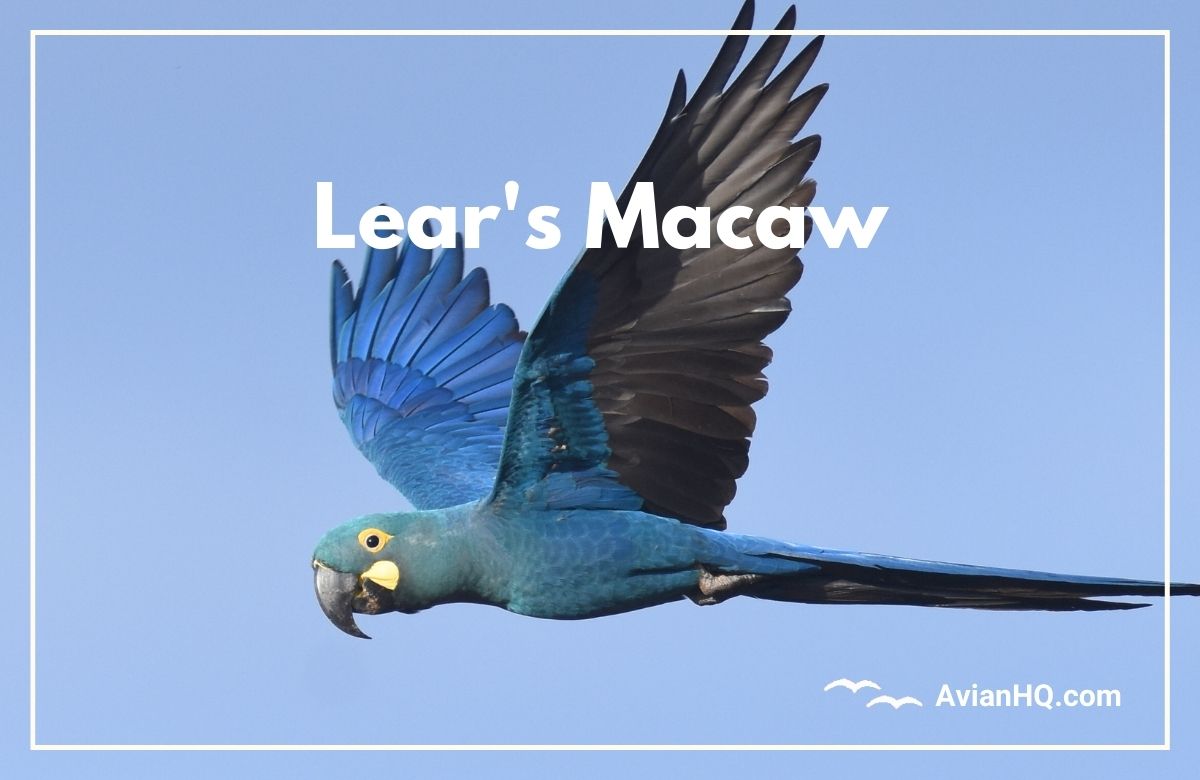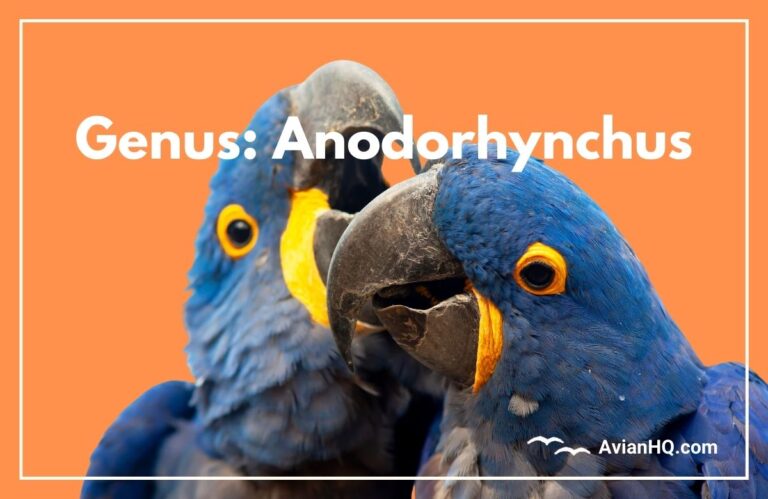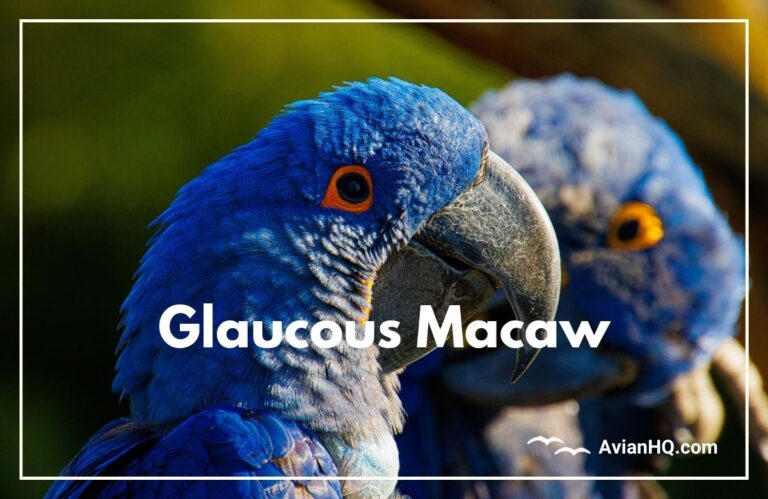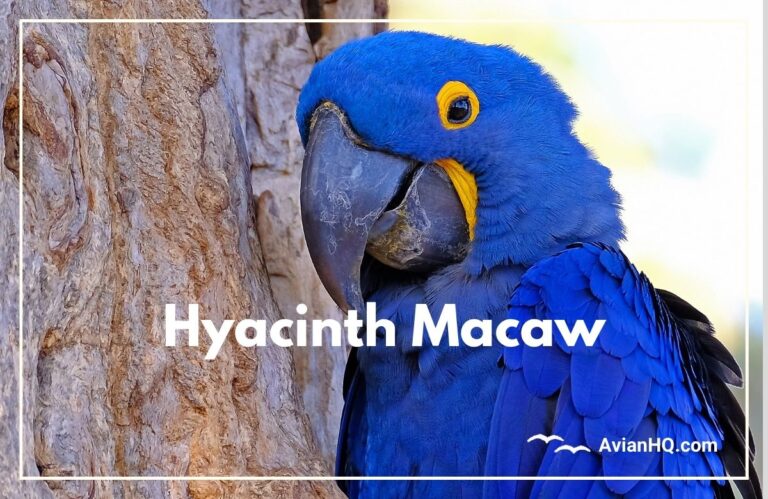Lear’s Macaw (Anodorhynchus leari)
You gaze up at the bright blue Brazilian sky and catch a glimpse of vibrant blue feathers flashing in the sunlight. A flock of large, brilliant blue macaws with long tails are soaring by. You’ve spotted the rare and beautiful Lear’s macaw!
These stunning parrots stand out with their striking indigo plumage and bright yellow eye rings. Measuring 27-30 inches (70-75 cm) long from beak to tail, they are a impressive sight.
Lear’s macaws are endemic to Brazil, meaning they only exist in the wild in one small region of that country. Their restricted range and small populations put them at risk, so they are classified as Endangered.
“Lear’s macaws represent one of great conservation success stories of recent decades. From fewer than 100 birds in the 1980s, the wild population now numbers over 1,600 thanks to intense recovery efforts.”
In this article, you’ll learn all about these magnificent birds, including:
- Their natural history and discovery
- Physical description
- Habitat needs
- Diet and feeding behaviors
- Breeding and reproduction
- Current conservation story
- Threats they still face
- Efforts to protect them
So get ready to meet one of the rarest, most spectacular parrots on Earth!
History and Taxonomy
The Lear’s macaw has a fascinating history that intertwines with the famous English poet and artist Edward Lear. These rare birds remained mysterious and elusive long after their initial discovery. Scientists debated whether they were even a distinct species until recent decades.
First Discovery
The Lear’s macaw was first spotted by European naturalists in 1820 when explorer Georg Wilhelm Freyreiss came across the birds while traveling in northeastern Brazil. However, the macaws weren’t studied or classified until over 30 years later.
Scientific Name and Meaning
These parrots were finally named and described scientifically in 1856 by French ornithologist Charles Lucien Bonaparte. He chose to name the new species after the accomplished artist and nonsense poem writer Edward Lear.
The genus name Anodorhynchus refers to the lack of feathers around the macaw’s eyes. The species name leari honors Mr. Lear for his early drawings of the bird.
Classification Debate
Lear collected and painted images of exotic parrots he saw in European zoos and aviaries in the 1830s. One painting likely depicts the macaw that now bears his name, though he called it a hyacinth macaw at the time.
The two species share some visual similarities which caused taxonomists to debate the classification of Lear’s macaw for over a century after its discovery. It wasn’t until the late 1970s that German ornithologist Helmut Sick located wild populations in Brazil and confirmed it as a valid species.
Subspecies
Currently scientists recognize no differentiated subspecies of the Lear’s macaw. All known populations show consistent physical and genetic traits.
Distribution
This species remains endemic to a small region of northeast Brazil to this day. The total global population resides in just two small colonies about 75 miles (120 km) apart in inland Bahia state. Their restrictive range puts them at higher risk of extinction.
Physical Appearance
The Lear’s macaw is considered one of the most visually stunning parrots in the world. Its bright blue plumage and unique facial markings make this large bird a real show-stopper.
Size and Weight
These parrots measure approximately 27-30 inches (70-75 cm) long. Their long, graduated tails account for over half their body length.
Lear’s macaws are estimated to weigh around 2-3 pounds (950-1300 grams) on average.
Plumage Colors and Markings
- Bright metallic indigo blue overall
- Slightly paler blue on the head
- Yellow bare skin patch at base of black bill
- Bright orange-yellow eye rings
- BlackISH gray feet
- Dark blue wings and tail with greenish tinge
- Undersides of wings and tails black
The feathers of juveniles have a more grayish cast until their first molt. Hatchlings are nearly featherless and very pale in color.
Differences Between Subspecies
No differentiated subspecies of Lear’s macaw have been identified across their small native range. All known populations show uniform physical and genetic traits.
Facial Features
In addition to its vibrant plumage colors, the Lear’s macaw has distinctive facial features:
- Large grayish black beak – Its heavy chisel-tipped bill is specialized for cracking hard nuts and seeds. Length: 2-3 inches (5-7 cm)
- Bare yellow skin patch – This distinctive mark extends along the bottom edge of its black beak.
- Yellow eye rings – Bright orange rings of feathers encircle their brownish eyes.
Legs and Feet
Their foot structure is zygodactyl, with two toes pointing forward and two facing backwards to allow for grasping and perching. The feet and sharp black talons are grayish black, blending with the darkness of their undersides while perched.
Habitat and Distribution
The limited range and specialized habitat needs of this endangered macaw contribute to its vulnerable conservation status. Protecting its dry forest ecosystem is key to the species’ survival.
Native Range and Habitat
Lear’s macaws are endemic to the interior regions of the Brazilian state of Bahia. They reside in the arid, desert-like caatinga habitat on the Raso da Catarina plateau.
This dry forest ecosystem receives erratic rainfall and hosts plants adapted to drought. The hardy licuri palm is a vital resource, providing food and nest sites. The birds also rely on sandstone cliffs containing crevices for roosting and shelter.
Introduced Populations
There are no records of successfully introduced wild populations of Lear’s macaw beyond their native range confines. A small number live in captivity in conservation breeding facilities in Brazil, Europe and the United States.
Elevation Range
This species occupies a narrow elevation band within its restricted range. It has been observed at elevations up to 1,200 feet (350 meters) across their foraging territories and nesting sites.
Protecting intact caatinga habitat across varying elevations offers the birds access to diverse food resources during seasonal shifts.
Diet and Feeding
The Lear’s macaw is specially adapted to take advantage of the hardy desert palm that forms a keystone species in its arid habitat. Its impressive beak allows it to access well-protected food resources.
| Wild Food Sources | Feeding Behavior | Food Preferences |
|---|---|---|
| Fruits (such as palm fruits) | Foraging in groups | Fruits |
| Nuts and seeds (including licuri palm nuts) | Using their beaks to crack open hard shells | Nuts and seeds |
| Flowers and nectar | Exploring different habitats | Flowers and nectar |
Overview of Diet in the Wild
This specialized parrot’s daily nutrition revolves around the licuri palm growing within its restricted range. The macaws use their powerful beaks to open the extremely dense nuts of this drought-resistant tree.
They supplement their palm-heavy diet with a variety of other regional fruits, seeds, nuts, and vegetation. Small amounts of corn and even insects get consumed at times.
Types of Foods Consumed
- Licuri palm nuts – This challenging food source makes up over 90% of observed diet. Each bird may eat up to 350 rock-hard nuts per day.
- Fruits – Native fruits like hog plum are eaten when available.
- Seeds and nuts – Other trees in the dry forest provide seasonal seeds and nuts.
- Corn – Staple grain grown by local farmers, sometimes raided.
- Insects – Small numbers of insects get consumed, likely for the protein.
- Agave flowers – The succulent flowers provide moisture.
Feeding Behaviors
The macaws use coordinated group behaviors while harvesting licuri nuts, their primary food.
- Small flocks fly together to palms stands across their range.
- First a pair will land to assess the quantity and ripeness of nuts.
- The pair returns to waiting flock members, then the entire group will descend if the spot looks productive.
- They use powerful curved beaks to tear open fruit pulp and access the extremely hard inner nut.
- Strong jaw muscles allow them crack open palm nuts.
- They drop and discard fibrous pulp debris below, leaving piles of shredded nuts.
Breeding and Reproduction
The breeding ecology of these rare parrots revolves around the seasonal cycles of rainfall and food availability in their arid habitat. Their reproduction rates are relatively low, which poses challenges for population growth.
| Aspect | Information |
|---|---|
| Nesting Sites | Licuri palm trees with large natural cavities |
| Clutch Size | 2 to 4 eggs |
| Incubation Period | 26 to 28 days |
| Fledging Time | 60 to 80 days |
Nesting Sites
- Nest in naturally formed cavities and crevices in eroded sandstone cliffs
- Rugged terrain offers protection from predators but limits expansion
- Some artificial nest boxes created in recent years to supplement sites
Clutch Size
- Typical clutch size ranges from 2-4 eggs
- Macaws lay more eggs than average survive to fledging
Incubation and Fledging
- Incubation lasts 26-28 days
- Eggs hatch asynchronously over several days
- Chicks fledge at 9-11 weeks old
- Parents continue to care for fledglings up to a year after leaving the nest
Protecting known nesting colonies and providing alternative sites are important conservation measures to boost reproductive capacity. Slow replacement rates make safeguarding adult birds vital for population stability.
Behavior and Ecology
The Lear’s macaw exhibits social behaviors and ecological relationships typical of large parrots. They form bonded pairs and congregate in flocks, communally nest, and play key functional roles in their ecosystem.
Flock Sizes
- Form long-term monogamous pairs
- Nest as isolated pairs but forage in groups
- Small flocks of 3-12 individuals observed foraging together
- May congregate in larger roosting flocks up to 50+ birds
Roosting in groups provides safety advantages. Synchronized foraging allows them to better access and transport food resources.
Roosting Patterns
- Nighttime communal roosts formed in eroded sandstone cliffs
- Cavity nests also used for overnight shelter
- Groups emerge loudly at dawn; return in late afternoon
Foraging and Feeding Behaviors
Their days revolve around foraging for food to meet their high metabolic needs.
- Depart cliff roosts in early morning
- Pairs or small flocks fly out to harvest licuri palm nuts
- Use sight skills finding distant fruiting trees up to 5 miles away
- Exhibit high daily activity modulated by heat
- Return in late afternoons to cliffside shelters
Ecosystem Interactions
As very mobile seed dispersers interacting with multiple plant species, these macaws likely play an important role distributing seeds across their habitat. Their specialized beaks also free up hard-to-access food resources other animals can exploit.
Despite small numbers they serve valuable ecosystem functions. Protecting connectivity between isolated groups supports genetic diversity and habitat resilience.
Conservation Status
Decades of intensive recovery efforts have led to a 30-fold increase in the global population of this endangered parrot. However, Lear’s macaws still face high risks of extinction without active management of remaining threats.
IUCN Status
The International Union for Conservation of Nature (IUCN) Red List categorizes this species as Endangered.
Though the wild population now numbers over 1,600 birds, their restricted endemic range and small population size make them vulnerable to habitat loss, trapping, nest failures, and other threats.
Population Estimates and Trends
- Historical records indicate a pre-conservation population low of just 60-70 birds in the 1980s
- Intensive protection efforts boosted the wild numbers to over 1,600 by 2018
- The growing population trend is positive if supported by habitat conservation
Major Threats
- Habitat loss – Clearing of native caatinga forest and licuri palms for agriculture
- Trapping – Capture for the illegal pet trade; reduced now but still occurs
- Predators – Native hawk, vulture, and mammalian species prey on eggs and chicks
- Invasive species – Africanized bees compete for nest sites and attack adults and chicks
Protection Efforts
- Habitat set-asides in state ecological reserves and national parks
- Restrictions on capture and transport
- Nest site protections and supplemental rearing boxes
- Anti-poaching enforcement
- Environmental education programs engagement local communities
Continued commitment to intensive management and guardian programs are essential to secure the future of this rare species in the wild.
Conclusion
The story of the Lear’s macaw showcases how intensely focused conservation efforts can bring endangered species back from the brink. Dedicated teams in Brazil partnered with international experts to build comprehensive programs reversing previous population crashes.
While serious threats remain, the outlook for these striking parrots has dramatically improved. Expanding protected habitat corridors, managing invasive species, increasing available nest sites, and reducing illegal trapping combine to support an upward trend.
With its total global population inhabiting just two small regions of one Brazilian state though, the Lear’s macaw remains classified as Endangered. Securing the stability of its dry forest ecosystem and keystone food resources continue to be top priorities.
The relationships people develop with rare and charismatic species like this often motivate broader habitat preservation. As flagship species grab attention and funding, the conservation spotlight they draw can also aid many other native but little-known plants and animals facing similar risks.
The Lear’s macaw’s limited numbers and restricted range mean it may always depend on active human custodianship. But this majestic parrot now flies a little more freely under wide blue Brazilian skies thanks to dedicated recovery teams and international collaborators supporting its long term survival.




